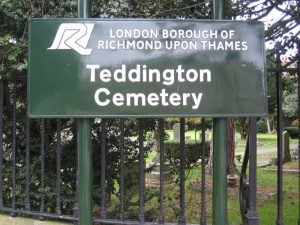COUNCIL PLANS TO EXTEND CEMETERY INTO ALLOTTMENT LANDS

The Teddington Society has highlighted a controversial planning application submitted by Richmond Council for a change of use of the Shacklegate Lane allotments for future use as an extension to the cemetery.
The Society say: “The allotments are one of few open spaces in Teddington and have been enjoyed for around 100 years.
“In recent years the Council has allowed the space to be run down and has prevented new applicants from taking over the unused plots.
“The Council wish to take over the site for burials and they estimate that that it will be used up in about 30 years.
“The Council’s own data indicates that there is a much unmet demand for allotments – there is a long waiting list for plots (around 3,500 requests).
“The loss of the Shacklegate Lane will mean that current holders may be offered alternative plots elsewhere, but the Council haven’t considered the needs of holders and the value of having such a valuable local space nearby.”
The Society adds: “If you care about the retention of this allotment space and its protection for current and future residents then please have your say by going to the planning website at https://planning.richmond.gov.uk/richmond/application-details/236643
Please note that the closing date for comments is 2 October 2025, should you wish to submit any.
One specific objection from an unnamed resident in Shacklegate Lane says the following:
1. Community & Wellbeing Value
ShacklegateLane Allotments are actively used by community groups including Age UK, and Ruils(which run gardening projects, including accessible raised beds and regular sessions), which support the elderly, those with mental health challenges, and people seeking social interaction and wellbeing.
These uses contribute substantially to physical and mental health, social inclusion, and provide a green, therapeutic space, especially valuable in a densely built environment. The loss of these functions would be deeply felt and difficult to mitigate.
2. High Demand and Scarcity of Allotments
Richmond Borough has many people on waiting lists for allotment plots; waiting times are very long (often over 5-10 years depending on site).
Shacklegate Lane’s plots are part of this constrained supply. Removing them would reduce the council’s capacity to meet existing demand.
3. Wildlife, Biodiversity and Environmental Value
The council’s own Allotments Terms & Conditions set out preserving wildlife and biodiversity as a secondary purpose of allotments. Shacklegate Lane likely already performs this function to some degree.
Any development would need to demonstrate Biodiversity Net Gain consistent with Richmond’s policies in the Local Plan / Open Land / biodiversity strategy (and national policy). Converting established green space tends to cause net loss unless exceptional mitigation proposed.
4. Policy Protections for Open Land
The Richmond Open Land Review (2021) provides designations (MOL, LGS, OOLTI etc.) for open land that should be protected. Even where Shacklegate Lane is not designated under one of these, proposals that affect open land identified in that review must show very strong justification.
The Local Plan (2018) includes policies for protecting open land, biodiversity, visual amenity, character and community amenity. Any change of use must be consistent with those policies.
5. Privacy, Disturbance, Visual Amenity and Character
Increased traffic, vehicle parking, visitation for funerals, maintenance etc. will cause noise, disturbance, and potential loss of privacy for adjacent residents. We have seen a rise in funerals attended by 200+ guests. After one particularly challenging example early in lockdown, a local resident and I collected 8 black bin bags full of rubbish. These ceremonies already bring the local area to a complete standstill, with significant noise, traffic and disorder issues. Bringing the cemetery grounds closer to resident’s housing is completely undesirable. The size and nature of many of these memorials is completely at odds with the current natural state of the allotments.
Increasing anti-social behaviour. There is regular drug-taking and general anti-social behaviour witnessed within the cemetery grounds. There is a huge difference for local residents having very quiet, daytime allotment visitors, with a gated environment as a buffer between them and the cemetery, to having the cemetery and visitorsimmediately adjacent to the boundary. Resident’s boundaries alongside and backing onto the proposed cemetery will be much more vulnerable to lack of privacy and a greater security risk.
Introduction of cemetery structures (memorials, paths, lighting, gates etc) will alter the character and appearance of the allotment area, reducing open green aspects, possibly creating intrusion into views, daylight, and residential amenity.
6. Lack of Evidence of Need or Strategy
A more robust, long-term strategy for burials is clearly required for this to be a sustainable solution beyond the lifespan of the current site. This is a piecemeal approach which will have a substantial impact on local residents and should be re-considered…it seems so short-sighted that weprioritize burial plots over living, natural, nurturing environments.
The Council’s evidence base (Open Land Review, Allotment Strategy) underscores need to protect green/open land and allotment provision; any conversion should show that there are no less harmful alternatives and that the proposal aligns with wider strategic plans.







